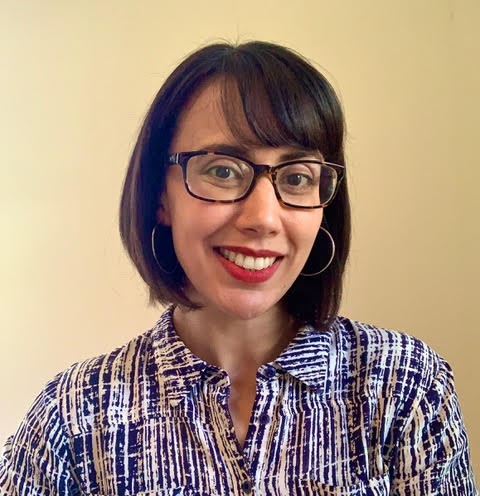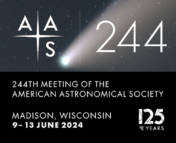In this series of posts, we sit down with a few of the keynote speakers of the 244th AAS meeting to learn more about them and their research. You can see a full schedule of their talks here, and read our other interviews here!

We all know that academic careers are usually a winding path and not a simple straight line. No one is a better example of this than Prof. Kerstin Perez, whose career in particle physics and astrophysics took her across multiple different research fields and at least two continents.
She started out as an undergraduate studying physics at Columbia University, and moved to Caltech to complete her doctorate. After she earned her Ph.D, she returned to Columbia as an NSF Fellow. She then accepted a faculty position at Haverford College before moving and joining the faculty at MIT as an assistant professor. Finally, she returned to Columbia University again and currently serves as their Lavine Family Associate Professor of the Natural Sciences in the Department of Physics. That’s already painting an impressive picture, and we haven’t even started discussing her research.
Prof. Perez’s reason for studying astronomy is very simple. “Basic scientific research is here to help us answer the big questions and uncover things that we don’t yet understand. Einstein wasn’t thinking about satellite communications when he described general relativity, but without general relativity, we wouldn’t have satellite communications. It’s the job of astrophysics to ask these big questions, even if they don’t go anywhere. Asking that question [why one studies astronomy] is, in my mind, the same as asking why we paint paintings and why we create art in any way. It’s all about how we understand our space in the universe, how we relate to the rest of the world, and how we relate to each other.”
Her science focuses on looking for dark matter interactions using cosmic rays in order to better understand or modify the Standard Model. In particular, she focuses on looking at extremely rare particles like antideuterons and hypothetical light particles like axions. In her quest to find these particles, Prof. Perez became a part of, and in some cases the leader of, many large science collaborations in particle physics and astronomy. So, let’s take a quick walk through some of her current projects as well as show a quick preview of her upcoming research!
NuStar
NuStar, or Nuclear Spectroscopic Telescope Array, is a NASA X-ray telescope that launched in 2012 and has been revolutionary in furthering the field of X-ray astronomy. However, while the primary intent of the telescope was to study black holes and supernova remnants, Prof. Perez had other uses for it. She originally got involved in the project as a postdoc, where she helped develop the optics for the telescope. “What happened in my career was I did [part of] my Ph.D at CERN. I was on the ATLAS experiment when it first turned on, and when I got to the end of my Ph.D, I still loved the fundamental particle physics questions, but I wanted to be part of building something new. That led me to the GAPS group at Columbia University since it was very similar physics. When I came here, I was in the same group that built the NuStar optics right when NuStar was launching.”
Now that it’s operational, she uses it to study potential X-ray probes of dark matter. “After I learned all the astrophysics and how all the instruments worked, I turned back to what we can do with particle physics using this same instrumentation? What kind of dark matter processes would give me X-rays? That’s where I pivoted with NuStar and did a lot of work with light dark matter candidates like sterile neutrinos and axions, as well as how we can probe them with astrophysics.”
GAPS
The General AntiParticle Spectrometer, or GAPS for short, is another mission in which Prof. Perez plays a large part. The goal of GAPS is to launch at least three balloon flights, lasting roughly 30 days each, in Antarctica to measure low-energy antideuterons, among other cosmic rays. “Originally, when I came into GAPS, I was developing the recipes for the semiconducting silicon detectors at the heart of the instrument.”
Recently, Prof. Perez took on the role of a project manager. “I’m now deputy PI (Principle Investigator) which means I’ll take over as primary investigator after flight one, and I’m also project manager of the whole project. This means I’m the one making sure all our trucks are getting from point A to point B and every moving part is on schedule and getting on the boats to Antarctica. Assuming it goes well, we will do our first flight at the end of this year. With these balloons, we want to fly again and again and again for the next five to ten years. I always say that every balloon mission wants to grow up to be a satellite, so assuming all goes well with those flights, we have a good idea what this would look like if we put it in space.”
Prof. Perez is also a part of two planned missions in the future. The first is HEX-P (High Energy X-ray Probe), a proposed NASA X-ray probe, and the second is IAXO (International Axion Observatory), an upcoming axion helioscope whose goal is to observe the Sun with incredibly powerful magnets in order to hopefully detect axions.
Lastly, she had some advice for all early career astronomers, including undergrads and grad students. “My number one advice for undergrads is to find your people! People who support you and make you laugh. Without that, I don’t think anyone makes it very far in this field. My other answer is to get some sleep!”
To hear more about Dark Matter, tune into Kerstin Perez’s Plenary Lecture at 11:40 AM CT on Thursday June 13th at #AAS244!
Edited by: Archana Aravindan
Featured Image Credit: AAS

